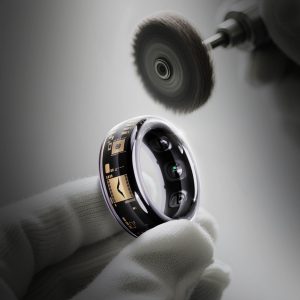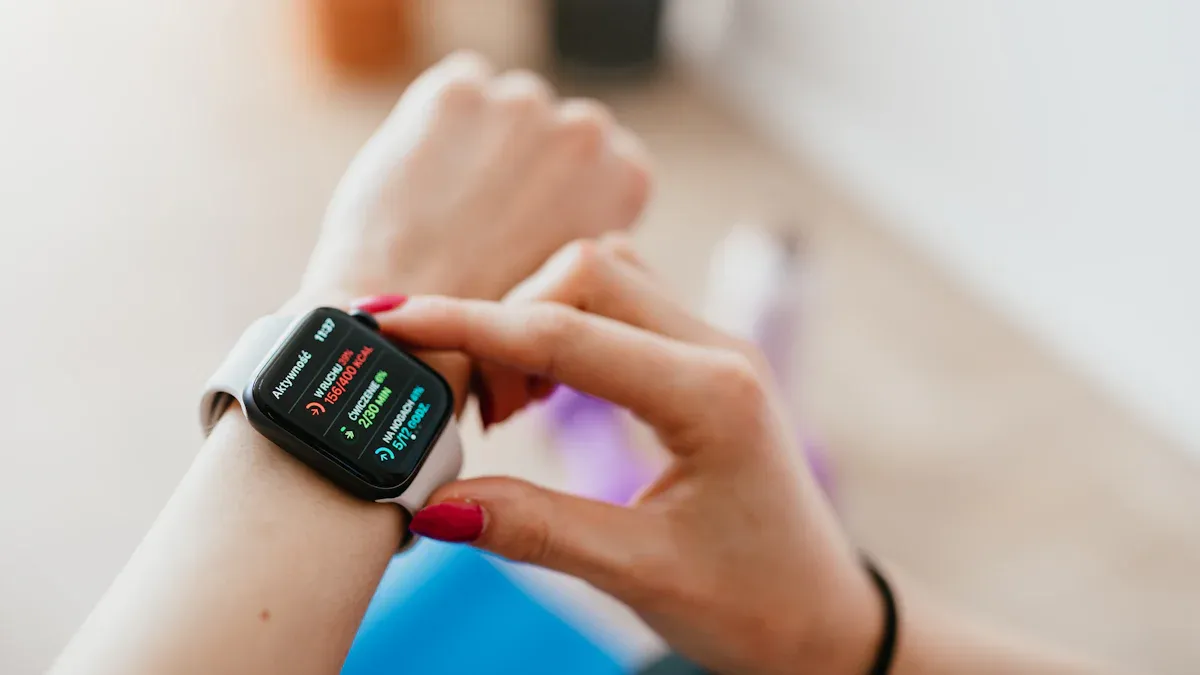
You can expect the normal pulse rate for women in 2025 to fall between 60 and 100 beats per minute, with an average healthy heart rate of 78 to 82 bpm. Your age affects this range. As you get older, your normal pulse rate for women tends to rise. Factors like stress, weight, and sleep also change your heart rate. See the table below for typical pulse rates by age group.
|
Age Group |
Normal Resting Heart Rate (bpm) |
|---|---|
|
18–25 years |
60–80 |
|
26–35 years |
60–82 |
|
36–45 years |
62–84 |
|
46–55 years |
64–86 |
|
56–65 years |
65–88 |
|
65+ years |
66–90 |
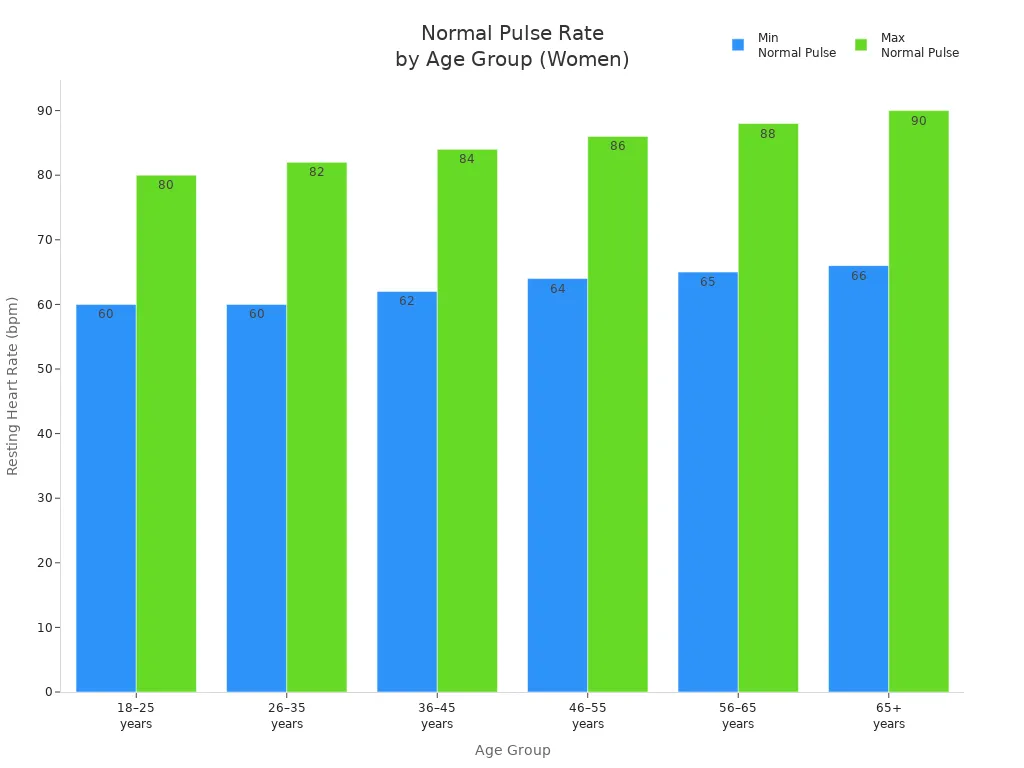
You can easily monitor your normal pulse rate for women using advanced health technology like the Aura Ring by VERTU, which delivers accurate, real-time tracking.
Key Takeaways
-
Normal pulse rates for women in 2025 are between 60 and 100 beats per minute. Most healthy adults have an average pulse rate of 78 to 82 bpm. Pulse rates can change because of age, hormones, fitness, stress, or sleep. Checking your heart rate often helps you know about your health. A resting heart rate under 60 bpm is normal for fit women. But it could mean a problem if you feel dizzy or weak. If your heart rate is over 100 bpm when resting, you should see a doctor. You can check your resting heart rate at home. Count your pulse for 15 seconds and multiply by four. It is best to do this right after you wake up. Healthy habits help keep your pulse rate safe. Exercise, good sleep, less stress, and not using caffeine or smoking are important.
Normal Pulse Rate for Women
Normal Heart Rate by Age
You may notice that your normal pulse rate for women changes as you grow older. Babies and young children have much higher heart rates than adults. As you age, your normal resting heart rate slows down and becomes more stable. For most women, the normal pulse rate for women falls between 60 and 100 beats per minute once you reach your teenage years and adulthood.
Here is a table that shows the normal resting heart rate for women and girls by age group in 2025:
|
Age Group |
Normal Resting Heart Rate Range (bpm) |
|---|---|
|
Newborns (birth to 4 weeks) |
100 to 205 |
|
Infants (4 weeks to 1 year) |
100 to 180 |
|
Toddlers (1 to 3 years) |
98 to 140 |
|
Preschoolers (3 to 5 years) |
80 to 120 |
|
School-age (5 to 12 years) |
75 to 118 |
|
Adolescents (13 to 18 years) |
60 to 100 |
|
Adults (18+ years) |
60 to 100 |
|
Adult Women (average) |
78 to 82 |
|
Well-trained adults |
40 to 60 |
You can see that the normal pulse rate for women is highest in newborns and infants. It drops as you get older and stays steady through adulthood. Most healthy adult women have a normal resting heart rate between 78 and 82 bpm, which is a bit higher than the average for men. This difference happens because women usually have smaller hearts, so your heart needs to beat faster to pump enough blood.
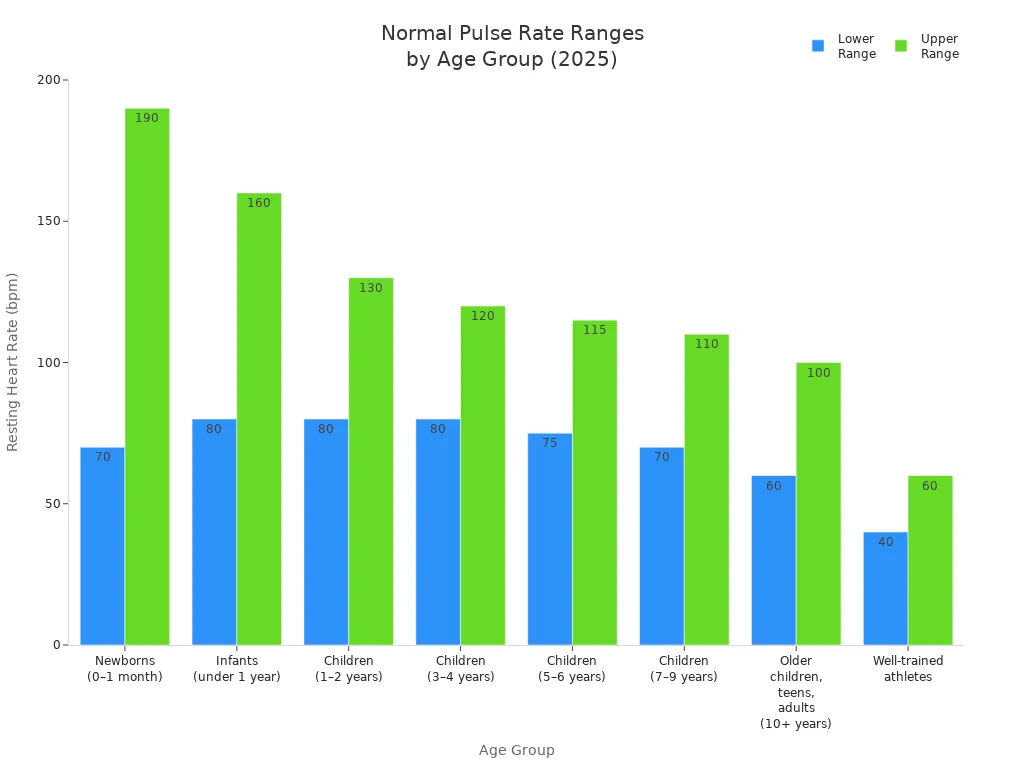
Note: Your normal heart rate can be affected by many things, such as your fitness level, emotions, and even the time of day.
Resting Heart Rate Ranges
Your resting heart rate tells you how many times your heart beats each minute when you are calm and not moving. Doctors use this number to check your heart health. For most women, a normal resting heart rate is between 60 and 100 bpm. If you are very fit, your resting heart rate might be lower, sometimes as low as 40 bpm.
The average resting heart rate for adult women in 2025 is about 78 to 82 bpm. This is a little higher than the average for men, which is usually around 70 to 72 bpm. Women’s resting heart rates are higher because of differences in heart size and hormones. For example, changes in estrogen during your menstrual cycle, pregnancy, or menopause can make your heart beat faster.
Here is another table that shows the average resting heart rates for women by age:
|
Age Range |
Average RHR (bpm) |
|---|---|
|
18-25 |
74-78 |
|
26-35 |
73-76 |
|
36-45 |
74-78 |
|
46-55 |
74-77 |
|
56-65 |
74-77 |
|
65+ |
73-76 |
You can use your resting heart rate to check your fitness. If your number is lower, it often means your heart is strong. If your number is higher, it may mean you need more exercise or should talk to your doctor.
When you exercise, your heart rate goes up. Doctors use your maximum heart rate to help you find your target heart rate zone for safe and effective workouts. You can find your maximum heart rate by subtracting your age from 220. For example, if you are 30 years old, your maximum heart rate is about 190 bpm. Your target heart rate zone is usually 50% to 85% of your maximum heart rate.
Here is a chart that shows target and maximum heart rates for women by age:
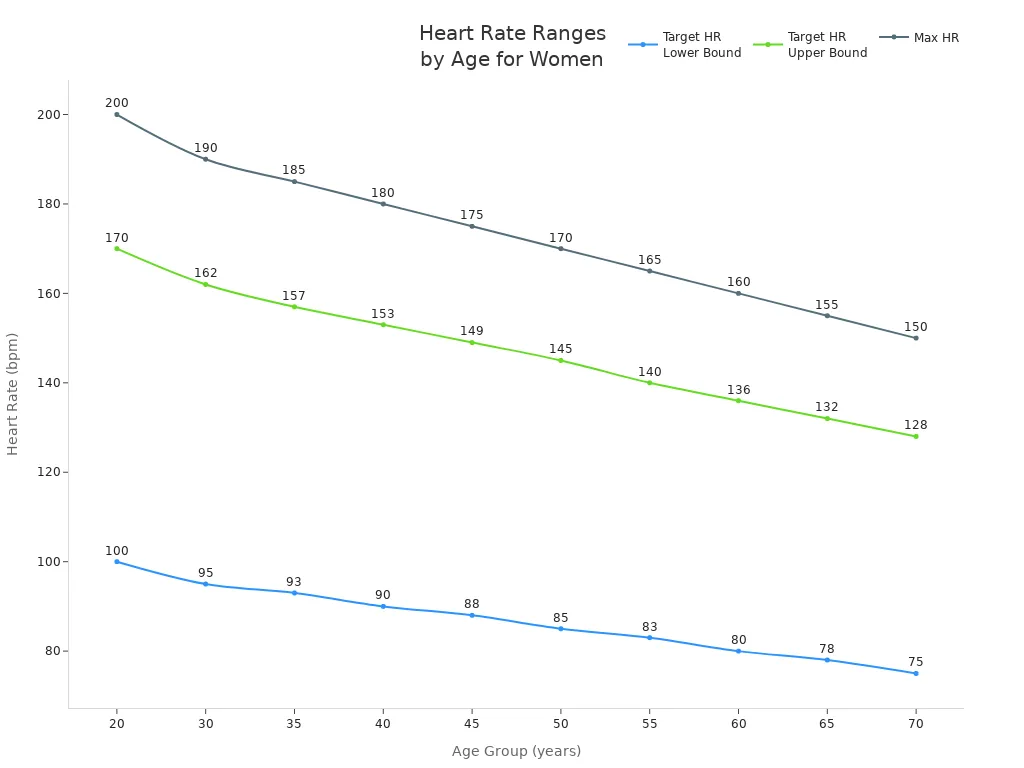
Tip: Knowing your normal resting heart rate and your maximum heart rate helps you track your health and exercise safely.
Pulse Rate Meaning
What is Too High or Too Low
It is important to know what a normal resting heart rate is. You should also know when your pulse is not in the healthy range. Doctors use certain numbers to check if your heart rate is too high or too low. The table below shows the usual ranges for women in 2025:
|
Pulse Rate Range (bpm) |
Interpretation |
Notes |
|---|---|---|
|
60 – 100 |
Normal resting heart rate |
Typical range for adults, including women |
|
> 100 |
Tachycardia (too high) |
Too high at rest; may be dangerous with symptoms like chest pain |
|
< 60 |
Bradycardia (too low) |
Too low except in athletes or very fit individuals |
If your pulse is over 100 bpm while resting, it is called tachycardia. If your pulse is under 60 bpm and you are not an athlete, it is called bradycardia. Both can mean there is a health problem, especially if you feel dizzy or have chest pain. Most adults should have a normal resting heart rate between 60 and 100 bpm.
Health Implications
Your pulse rate shows how well your heart and body work together. Many things can change your normal resting heart rate. Hormones, like during your menstrual cycle, can make your heart beat faster or slower. Here are some main ways your pulse rate is controlled:
-
Hormone changes, like estrogen and progesterone, affect your heart and nerves.
-
Your pulse often goes up during ovulation and the luteal phase.
-
The autonomic nervous system helps control your heart rate with nerve signals.
-
Wearable devices can track these changes and show patterns linked to your cycle.
-
These systems work together to keep your resting heart rate in a healthy range.
Sometimes, your pulse rate can go outside the normal range. High blood pressure with a low pulse can mean there is a problem with your heart’s electrical system. Brain problems, like swelling or bleeding, can also cause a slow heart rate and high blood pressure. Other causes are medicines, thyroid problems, stress, sickness, and lifestyle choices.
|
Examples and Details |
|
|---|---|
|
Low Pulse (Bradycardia) |
Medications, hypothyroidism, hypothermia, heart conditions, high fitness |
|
High Pulse (Tachycardia) |
Stress, anxiety, fever, illness, arrhythmias, caffeine, nicotine, certain drugs |
|
Heart Conditions |
Coronary heart disease, heart failure, structural changes, damage after heart attack |
|
Other Factors |
Electrolyte imbalances, sleep apnea, anemia, pain |
|
Lifestyle and Risk |
Smoking, diabetes, stress, overweight, inactivity, high-fat diet, alcohol, drug misuse |
You might feel chest pain, dizziness, or shortness of breath if your pulse is not in the normal range. Stress, caffeine, and some drugs can make your heart rate go up fast. If your heart rate changes quickly or feels strange, you should talk to a doctor. Watching your heart rate and knowing your maximum heart rate helps you stay safe and find problems early.
Tip: Controlling stress and checking your resting heart rate can help you avoid heart problems. Smart devices make it easier to see changes and get help if you need it.
Pulse Rate Factors
Modifiable Factors
You can change some things that affect your pulse rate. These are called modifiable factors. Making healthy choices helps your heart work better. It also keeps your pulse in a safe range.
|
Modifiable Lifestyle Factor |
Influence on Pulse Rate |
Supporting Actions |
|---|---|---|
|
Physical fitness level |
Regular aerobic exercise lowers resting heart rate by improving heart efficiency |
Engage in activities like walking, swimming, biking, jogging |
|
Stress and emotional health |
Anxiety and chronic stress can raise heart rate |
Practice stress management techniques such as yoga, meditation, breathing exercises |
|
Sleep quality |
Poor or insufficient sleep often leads to higher resting heart rate |
Aim for 7–9 hours of restful sleep each night |
|
Hydration |
Dehydration can elevate heart rate |
Maintain consistent water intake throughout the day |
|
Nutrition and body weight |
Poor diet and obesity increase heart workload and pulse rate |
Follow a heart-healthy diet and manage weight |
|
Substance use (caffeine, alcohol, smoking) |
These stimulants can elevate resting heart rate |
Limit or avoid caffeine, alcohol, and tobacco use |
You can lower your pulse rate by doing a few things. Try deep breathing to help with stress. Drink less caffeine and alcohol. Stop smoking if you can. Move your body with regular exercise. Make sure you get enough sleep every night.
Healthy habits, like eating good foods and handling stress, help keep your resting heart rate healthy.
Non-Modifiable Factors
Some things that affect your pulse rate cannot be changed. These are called non-modifiable factors. Your age, genes, and some health problems play a part.
-
As you get older, your heart’s pacemaker loses cells. This can slow your heart rate.
-
Your heart may get more fat and tough tissue as you age.
-
The wall of your heart can get thicker. Your heart might get a little bigger.
-
Genetics can change your normal heart rate and your risk for heart disease.
-
Family history can affect how your heart works.
-
Long-term diseases like heart disease, diabetes, or kidney problems can change your pulse rate.
Some medicines, like beta-blockers or calcium channel blockers, can slow your heart rate if you have certain health problems.
Note: You cannot change these things, but you can still help your heart by working on what you can control.
Hormonal Changes
Hormonal changes can really affect your pulse rate. When you are pregnant, your heart works harder. Your pulse rate often goes up. This is because your body needs to pump more blood for you and your baby. Menopause also changes your heart. When estrogen and progesterone go down, your heart rate changes. Your pulse rate may go up, and your risk for heart problems can rise.
Your menstrual cycle can also change your pulse rate. Many women see a higher pulse during the luteal phase, when progesterone is highest. Some studies show heart rate changes during different parts of the cycle. But these changes are not the same for everyone.
Hormonal changes during pregnancy, menopause, and your period mean you should check your heart health often.
Measuring Resting Heart Rate
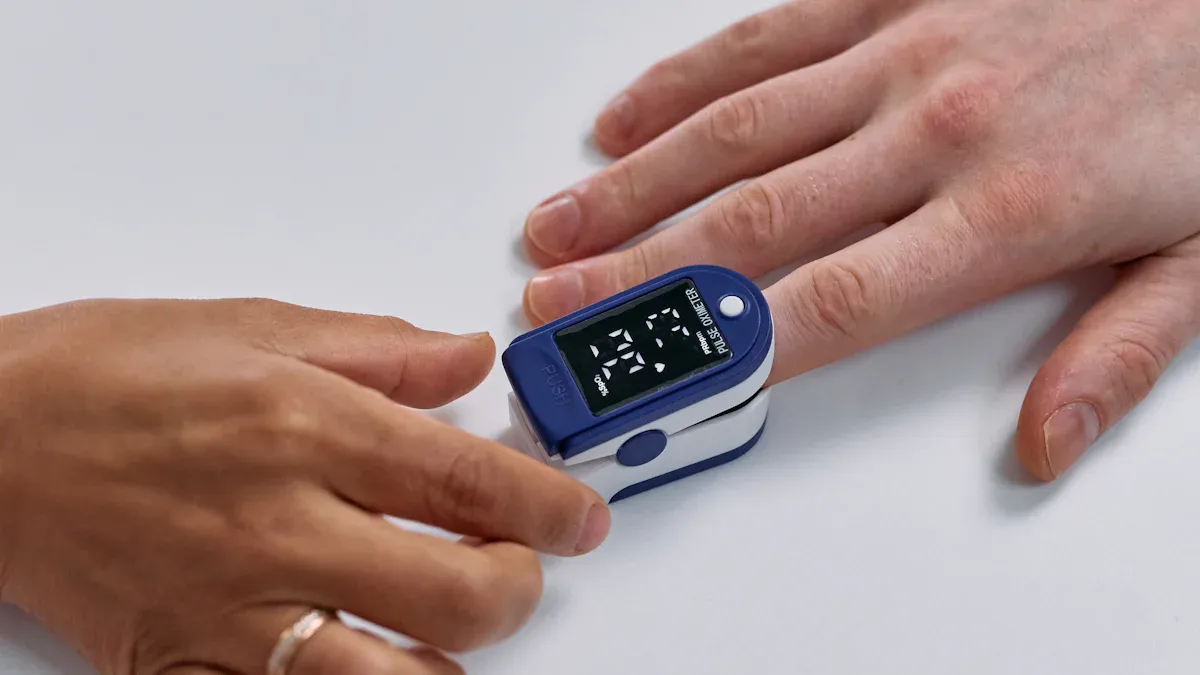
How to Measure
You can measure your resting heart rate at home with simple steps. You do not need special equipment. You only need a clock or watch that shows seconds. Follow these steps to get accurate resting heart rate readings:
-
Lie down or sit quietly for at least 5 minutes. This helps your heart settle into its resting rhythm.
-
Find your pulse. You can use your wrist (radial artery) or the side of your neck (carotid artery).
-
Place your index and middle fingers gently on the pulse point. Do not use your thumb because it has its own pulse.
-
Multiply the number by 4. This gives you your heart rate in beats per minute.
-
The best time to measure your resting heart rate is just before you get out of bed in the morning.
Tip: Your resting heart rate can change with age, activity, body position, emotions, and medications. Try to measure it at the same time each day for consistent readings.
Smart health devices make this process even easier. The Aura Ring by VERTU uses advanced sensors to track your resting heart rate automatically. You get continuous, accurate readings without needing to count beats yourself. The ring fits comfortably and works quietly, giving you real-time data and weekly wellness reports.
Tips for Accuracy
You want your resting heart rate readings to be as accurate as possible. Here are some best practices:
-
Choose a quiet, comfortable place. Avoid distractions and noise.
-
Use two or three fingertips with gentle pressure. Pressing too hard can block the pulse.
-
Count for 30 seconds and multiply by two if your pulse is regular. If your pulse feels uneven, count for a full minute.
-
Warm your fingers before measuring. Cold hands can make it harder to find your pulse.
-
Take multiple readings and average them for better reliability.
-
Keep a logbook of your resting heart rate readings. This helps you spot trends over time.
-
Use validated devices for home monitoring. Devices like the Aura Ring by VERTU use photoplethysmography (PPG) sensors, which research shows are highly accurate for heart rate tracking.
Note: Smart rings and wearables offer continuous monitoring and AI-guided feedback. These tools help you understand your heart’s rhythm and alert you to changes that may need attention.
|
Method |
Accuracy |
Comfort |
Monitoring Style |
|---|---|---|---|
|
Manual (count pulse) |
Good |
High |
Single reading |
|
Aura Ring by VERTU |
Very High |
Continuous, automatic |
|
|
Clinical ECG |
Gold standard |
Low |
Intermittent, clinical |
You can use these tips and tools to get the most reliable resting heart rate readings at home.
Try to keep your resting pulse rate from 60 to 100 beats per minute. Checking your pulse often helps you find heart problems early. It also helps you see how hormones, stress, or changes in your life affect your heart.
-
Use smart rings or chest strap monitors for easy and correct tracking.
-
Look out for signs like feeling dizzy, chest pain, or fainting.
-
If your pulse is always too high or too low, or you feel strange symptoms, talk to a doctor for help.
التعليمات
What is a normal pulse rate for women during sleep?
Your pulse rate usually drops while you sleep. Most women see their heart rate fall to 50–70 beats per minute at night. This lower rate helps your body rest and recover.
Can stress affect my pulse rate?
Yes, stress can raise your pulse rate. When you feel anxious or upset, your body releases hormones that make your heart beat faster. Deep breathing and relaxation can help lower your heart rate.
How often should I check my resting heart rate?
You should check your resting heart rate once a day, preferably in the morning before you get out of bed. Regular tracking helps you notice changes in your heart health.
Is it normal for my pulse rate to change during my period?
Yes, your pulse rate can change during your menstrual cycle. Hormone shifts, especially during the luteal phase, may cause your heart rate to rise slightly. This is normal for many women.
What is the best way to track my pulse rate daily?
Smart rings like the Aura Ring by VERTU give you continuous, automatic heart rate tracking. You can also use a smartwatch or count your pulse manually for a quick check.




